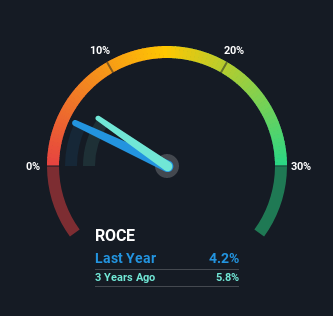- New Zealand
- /
- Telecom Services and Carriers
- /
- NZSE:CNU
The Returns On Capital At Chorus (NZSE:CNU) Don't Inspire Confidence

Finding a business that has the potential to grow substantially is not easy, but it is possible if we look at a few key financial metrics. One common approach is to try and find a company with returns on capital employed (ROCE) that are increasing, in conjunction with a growing amount of capital employed. Put simply, these types of businesses are compounding machines, meaning they are continually reinvesting their earnings at ever-higher rates of return. Having said that, from a first glance at Chorus (NZSE:CNU) we aren't jumping out of our chairs at how returns are trending, but let's have a deeper look.
Understanding Return On Capital Employed (ROCE)
For those that aren't sure what ROCE is, it measures the amount of pre-tax profits a company can generate from the capital employed in its business. To calculate this metric for Chorus, this is the formula:
Return on Capital Employed = Earnings Before Interest and Tax (EBIT) ÷ (Total Assets - Current Liabilities)
0.042 = NZ$226m ÷ (NZ$5.9b - NZ$461m) (Based on the trailing twelve months to June 2021).
Thus, Chorus has an ROCE of 4.2%. In absolute terms, that's a low return and it also under-performs the Telecom industry average of 5.9%.
View our latest analysis for Chorus

In the above chart we have measured Chorus' prior ROCE against its prior performance, but the future is arguably more important. If you're interested, you can view the analysts predictions in our free report on analyst forecasts for the company.
What Can We Tell From Chorus' ROCE Trend?
The trend of ROCE doesn't look fantastic because it's fallen from 7.2% five years ago, while the business's capital employed increased by 46%. That being said, Chorus raised some capital prior to their latest results being released, so that could partly explain the increase in capital employed. Chorus probably hasn't received a full year of earnings yet from the new funds it raised, so these figures should be taken with a grain of salt.
The Key Takeaway
Bringing it all together, while we're somewhat encouraged by Chorus' reinvestment in its own business, we're aware that returns are shrinking. Yet to long term shareholders the stock has gifted them an incredible 129% return in the last five years, so the market appears to be rosy about its future. However, unless these underlying trends turn more positive, we wouldn't get our hopes up too high.
One more thing to note, we've identified 2 warning signs with Chorus and understanding them should be part of your investment process.
While Chorus may not currently earn the highest returns, we've compiled a list of companies that currently earn more than 25% return on equity. Check out this free list here.
New: AI Stock Screener & Alerts
Our new AI Stock Screener scans the market every day to uncover opportunities.
• Dividend Powerhouses (3%+ Yield)
• Undervalued Small Caps with Insider Buying
• High growth Tech and AI Companies
Or build your own from over 50 metrics.
This article by Simply Wall St is general in nature. We provide commentary based on historical data and analyst forecasts only using an unbiased methodology and our articles are not intended to be financial advice. It does not constitute a recommendation to buy or sell any stock, and does not take account of your objectives, or your financial situation. We aim to bring you long-term focused analysis driven by fundamental data. Note that our analysis may not factor in the latest price-sensitive company announcements or qualitative material. Simply Wall St has no position in any stocks mentioned.
Have feedback on this article? Concerned about the content? Get in touch with us directly. Alternatively, email editorial-team (at) simplywallst.com.
About NZSE:CNU
Chorus
Engages in the provision of fixed line communications infrastructure services in New Zealand.
Reasonable growth potential and fair value.
Market Insights
Community Narratives




